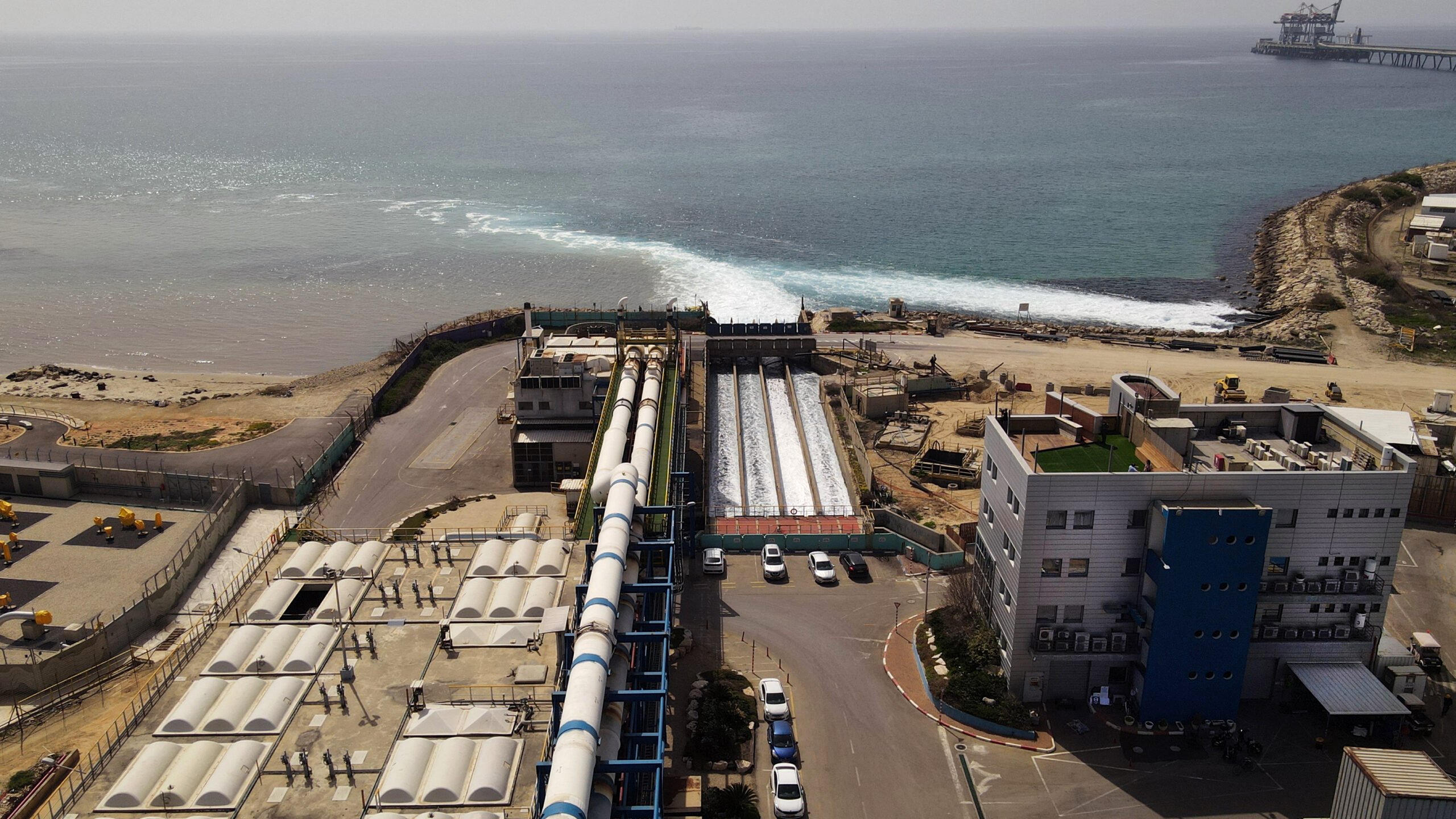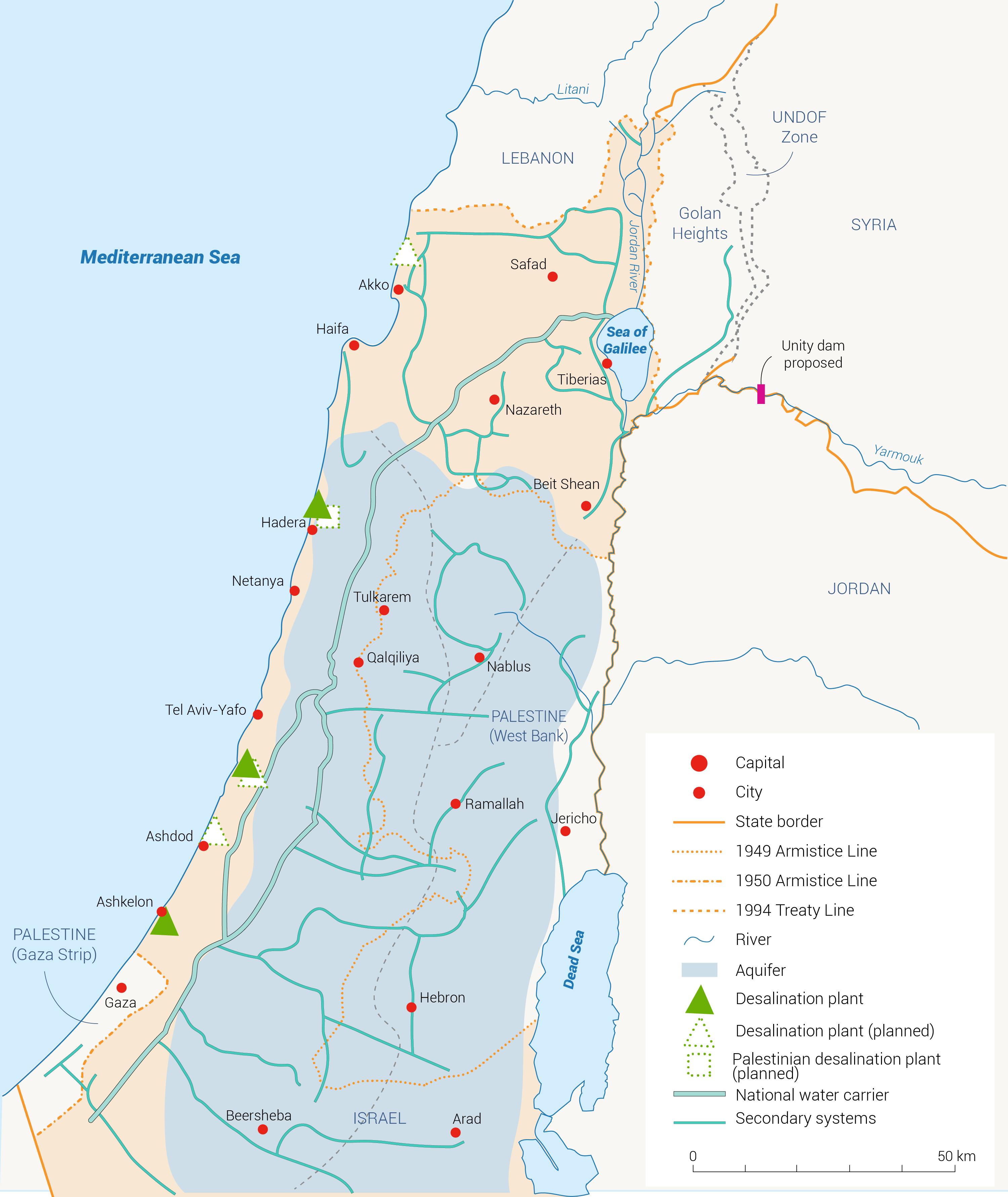
Desalination
Almost 90% of the desalinated water is produced in five seawater desalination plants: Ashkelon, Palmachim, Hadera, Sorek and Ashdod , which produce a total of 50% of the potable water in Israel.[1] The remainder is produced in saline groundwater desalination plants, most of them in the Arava area.
Table 1. Seawater desalination plants in Israel. Source: reproduced from Wikipedia.[6]
| Location | Production rate (MCM\yr) | Cost (shekel\m3) | Year of operation |
| Ashkelon | 120 | 2.9 | 2005 |
| Palmachim | 90 | 2.6 | 2007 |
| Hadera | 145 | 2.6 | 2010 |
| Sorek | 150 | 2.01-2.19 | 2013 |
| Ashdod | 100 | 2.4 | 2015 |
The desalination plants are strategically distributed along the Mediterranean coast from where the seawater is extracted. They are also connected to the National Water Carrier (NWC), which conveys water along the north-south axis of the country between regions with different climatic conditions and precipitation amounts.
The timely development of these desalination plants compensates for the increasing water demand and decreasing natural water quantity and quality. The positioning of the desalination plants was well planned to address the needs of highly populated areas in combination with the prevalent water shortages.
Initially, there was a shortage of water in the arid south. Therefore, the strategy was to convey water from the Sea of Galilee in the water-rich north, via the NWC, to the arid south. However, an increase in the water demand in the southern and central parts of the country put a strain on the Sea of Galilee as the main source of fresh water. Hence, the Israeli water sector started to incorporate a wide range of creative technological solutions to bridge the gap between water supply and demand. These included more efficient irrigation systems, recycled and brackish water for irrigation and desalinated water.[4] [5]
Israel’s desalination breakthrough has been accompanied by an evolving national water management strategy .[7] Thanks to the NWC, the south became water abundant, but at the expense of the north, which became water scarce.[8] [9] In recent years, the strategy has therefore shifted towards tackling water shortage in the north by building a new desalination plant on the north coast,[7] [10] as well as New National Water Carrier (NNWC), which reverses the flow of water in the NWC, transporting it from south to north.[11]
According to the Israel Water Authority, the integration of desalinated water in the national system improves the quality of fresh water and effluent water for agriculture and reduces the salinity of soils and groundwater. It also enables stability and reliability in the water supply to the economy.[2] On the other hand, desalination also has economic and environmental costs, including high energy consumption and a resulting increase in air pollution, chemical consumption, seizure of coastal areas and an adverse effect on the marine ecosystem.[3] In addition, desalination produces iodine-depleted desalinated seawater, which causes a serious public health problem.[12]
Wastewater treatment plants
There are a total of 87 large wastewater treatment plants (WWTPs) in Israel. These all treat at least 1,000 m3 wastewater per day or 503.3 MCM per year.
The Shafdan plant is by far the largest WWTP. The plant lies on the outskirts of Tel Aviv and treats wastewater from 35 municipalities. It serves approximately 2.3 million people.
Below is an overview of the ten largest WWTPs and their discharge (Table 2).
Table 2. The ten largest wastewater treatment plants in Israel and their discharge. Source: https://www.gov.il/.
| WWTP, >1000CM\day | Discharge 2017 - MCM\Yr |
| SHAFDAN | 140.0 |
| Haifa | 37.3 |
| Jerusalem | 35.1 |
| Ayalon | 21.2 |
| Netanaya | 17.1 |
| Beer Sheva | 16.4 |
| Ashdod | 11.4 |
| Kfar Saba Hod Hsharon | 11.1 |
| Hedera | 10.5 |
| Karmiel | 10.1 |
[1] Kramer, I., Tsairi, Y., Roth, M.B., Tal, A. and Mau, Y., 2022. ‘Effects of population growth on Israel’s demand for desalinated water.’ npj Clean Water 5, 67.
[2] Tenne, A., 2010. Sea Water Desalination in Israel: Planning, Coping with Difficulties, and Economic Aspects of Long-term Risks. Israel Water Authority – State of Israel Desalination Division.
[3] Roth, M.B. and Tal, A, 2022. ‘The ecological tradeoffs of desalination in land-constrained countries seeking to mitigate climate change.’ Desalination 529, 2022, 115607.
[4] Amnesty International, 2017. ‘The occupation of water.’ Published on 29 November 2017.
[5] Inbar, E., 2011. ‘Israeli control of the Golan Heights: High strategic and moral ground for Israel.’ Mideast Security and Policy Studies No. 90.
[6] Wikipedia, n.d. ‘Water supply and sanitation in Israel.’
[7] Tal, A., 2006. ‘Seeking sustainability: Israel’s evolving water management strategy.’ Science 313, 5790: 1081-1084.
[8] Raveh, E. and Ben-Gal, A., 2018. ‘Leveraging sustainable irrigated agriculture via desalination: Evidence from a macro-data case study in Israel.’ Sustainability 10(4), 974.
[9] Pearce, F., 2019. ‘In Israel, questions are raised about a forest that rises from the desert.’ Yale Environment 360. Published on 30 September 2019.
[10] Wine, M.L., Rimmer, A. and Laronne, J.B., 2019. ‘Agriculture, diversions, and drought shrinking Galilee Sea.’ Science of the Total Environment 651: 70-83.
[11] Dori, O., 2022. ‘Reverse water carrier launched to refill Kinneret.’ Globes. Published on 27 December 2022.
[12] Barnett-Itzhaki, Z., Ehrlich, D., Troen, A.M. et al., 2022. ‘Results of the national biomonitoring program show persistent iodine deficiency in Israel.’ Israel Journal of Health Policy Research 11, 18.

